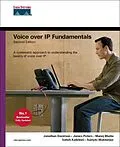A systematic approach to understanding the basics of voice over IP
Voice over IP (VoIP) has become an important factor in network communications, promising lower operational costs, greater flexibility, and a variety of enhanced applications. To help you understand VoIP networks, Voice over IP Fundamentals provides a thorough introduction to the basics of VoIP.
Voice over IP Fundamentals explains how a basic IP telephony infrastructure is built and works today, major concepts concerning voice and data networking, and transmission of voice over data networks. You'll learn how voice is signaled through legacy telephone networks, how IP signaling protocols are used to interoperate with current telephony systems, and how to ensure good voice quality using quality of service (QoS).
Even though Voice over IP Fundamentals is written for anyone seeking to understand how to use IP to transport voice, its target audience comprises both voice and data networking professionals. In the past, professionals working in voice and data networking did not have to understand each other's roles. However, in this world of time-division multiplexing (TDM) and IP convergence, it is important to understand how these technologies work together. Voice over IP Fundamentals explains all the details so that voice experts can understand data networking and data experts can understand voice networking.
The second edition of this best-selling book includes new chapters on the importance of billing and mediation in a VoIP network, security, and the common types of threats inherent when packet voice environments, public switched telephone networks (PSTN), and VoIP interoperate. It also explains enterprise and service-provider applications and services.
Autorentext
Jonathan Davidson, CCIE No. 2560, is the Director of SP Solution Engineering in Integrated Network Systems Engineering. He has co-authored Voice over IP Fundamentals and edited Deploying Cisco Voice over IP. He has been with Cisco for 10 years in post-sales support, marketing, and engineering divisions.
James Peters is the Director of Product Marketing in the Carrier Core and Multiservice Business Unit at Cisco Systems. He co-authored the first edition of Voice over IP Fundamentals and is currently authoring a book on multiservice networking. James has more than 20 years experience in building, designing Internet-based voice and data networks, and product development.
Manoj Bhatia is a Business Development Manager for Partner Programs at IP Communications Business Unit (IPCBU) for Cisco Systems, Inc. He was among the first to start the software development for SIP technology on Cisco VoIP gateways and IOS-based routers. His past projects include technical marketing for VoIP products such as media gateways, call agents, and SIP-based residential voice solutions. Prior to Cisco, Manoj worked in Nortel Networks and Summa Four (now Cisco) and has 14+ years of experience in telephony protocols such as SS7, call control, and VoIP technologies.
Satish Kalidindi is a Software Engineer with Cisco Systems. He has more than six years experience working on development and deployment of VoIP technologies. He has been involved with various products, including IOS gateways and Cisco CallManager. More recently he has been involved with security features on CCM. He is a graduate of Purdue University with an M.S in Engineering.
Sudipto Mukherjee is a Software Development Engineer with Cisco Systems. He has product development and deployment experience for a variety of telecommunication devices for wireline, wireless, and VoIP networks. More recently at Cisco he has been working on SIP gateway development. Sudipto has a Bachelors of Engineering degree in Electronics Communication engineering from GS Institute of Technology, Indore and a Masters degree in Electronics Design and technology from Indian Institute of Science, Bangalore.
Inhalt
Introduction
Part I PSTN
Chapter 1 Overview of the PSTN and Comparisons to Voice over IP
The Beginning of the PSTN
Understanding PSTN Basics
Analog and Digital Signaling
Digital Voice Signals
Local Loops, Trunks, and Interswitch Communication
PSTN Signaling
PSTN Services and Applications
PSTN Numbering Plans
Drivers Behind the Convergence Between Voice and Data Networking
Drawbacks to the PSTN
Packet Telephony Network Drivers
Standards-Based Packet Infrastructure Layer
Open Call-Control Layer
VoIP Call-Control Protocols
Open Service Application Layer
New PSTN Network Infrastructure Model
Summary
Chapter 2 Enterprise Telephony Today
Similarities Between PSTN and ET
Differences Between PSTN and ET
Signaling Treatment
Advanced Features
Common ET and PSTN Interworking
ET Networks Provided by PSTN
Private ET Networks
Summary
Chapter 3 Basic Telephony Signaling
Signaling Overview
Analog and Digital Signaling
Direct Current Signalin8
In-Band and Out-of-Band Signaling
Loop-Start and Ground-Start Signaling
CAS and CCS
E&M Signaling
Type I
Type II
Type III
Type IV
Type V
CAS
Bell System MF Signaling
CCITT No. 5 Signaling
R1
R2
ISDN
ISDN Service5
ISDN Access Interface6
ISDN L2 and L3 Protocols
Basic ISDN Call
QSIG
QSIG Service4
QSIG Architecture and Reference Points
QSIG Protocol Stac5
QSIG Basic Call Setup and Teardown Example
DPNSS
Summary
Chapter 4 Signaling System 7
SS7 Network Architecture
Signaling Elements
Signaling Links
SS7 Protocol Overview
Physical Layer-MTP L1
Data Layer-MTP L2
Network Layer-MTP3
SCCP
TUP
ISUP
TCAP
SS7 Examples
Basic Call Setup and Teardown Example
800 Database Query Example
List of SS7 Specifications
Summary
Chapter 5 PSTN Services
Plain Old Telephone Service
Custom Calling Features
CLASS Features
Voice Mail
Business Services
Virtual Private Voice Networks
Centrex Services
Call Center Services
Service Provider Services
Database Service
Operator Services
Summary
Part II Voice over IP Technology
Chapter 6 IP Tutorial
OSI Reference Model
The Application Layer
The Presentation Layer
The Session Layer
The Transport Layer
The Network Layer
The Data Link Layer
The Physical Layer
Internet Protocol
Data Link Layer Addresses
IP Addressing
Routing Protocols
Distance-Vector Routing
Link-State Routing
BGP
IS-IS
OSPF
IGRP
EIGRP
RIP
IP Trans…
